News Based on facts, either observed and verified directly by the reporter, or reported and verified from knowledgeable sources.
Protecting Children and Healing Families, One Native Auntie at a Time
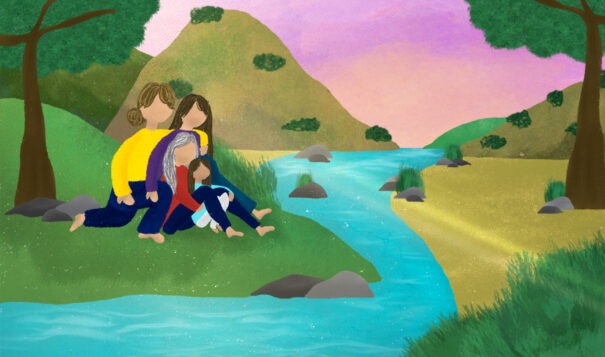 Illustration by Christine Ongjoco for The Imprint
Illustration by Christine Ongjoco for The Imprint
The My Two Aunties program provides Native families with trained home visitors who help build family resilience, honor and respect for elders, reminding participants that children are “gifts of responsibility.”
This story is being co-published with The Imprint, a national nonprofit news outlet covering child welfare and youth justice.
When two aunties visit parents in need, there is no scolding, shame or surveillance. Instead, they set themselves to the immediate tasks at hand on these southern California reservations — at times simply pitching in to fold a pile of laundry, or patting a baby to sleep with Kumeyaay lullabies.
Then there are the variety of lessons with mom and dad to nurture safe parenting that fold in traditional Indigenous teachings. Establishing family routines and healthy diets are taught alongside lessons in burning sage for cleansing, growing herbal medicines in a family’s backyard, and making basic introductions in a child’s Native language.
“As a home-based program, if both of the aunties come in, it’s not necessarily a reprimand,” said auntie Elizabeth “Lizzie” Lycett. “It’s, ‘Let me take care of the child over here, so you can have your class.’”
Since its formal inception in 2019, My Two Aunties has assisted hundreds of Indigenous families in California’s San Diego, Imperial and Riverside counties. From its base on the Rincon Indian Reservation, the small program with a staff of three is among the many ongoing efforts in Indian Country to keep children out of foster care and ensure Indigenous families remain safe and intact.
Beyond parenting support, the aunties seek to repair intergenerational trauma that can result in substance abuse, domestic violence and unsafe environments for children. They equip parents with cultural tools through “Indigenous Ways Of Knowing” that they may have missed out on due to their own childhoods in foster and adoptive homes. The goals are to reduce family separation, build parents’ trust in social services and help members of tribal communities heal.
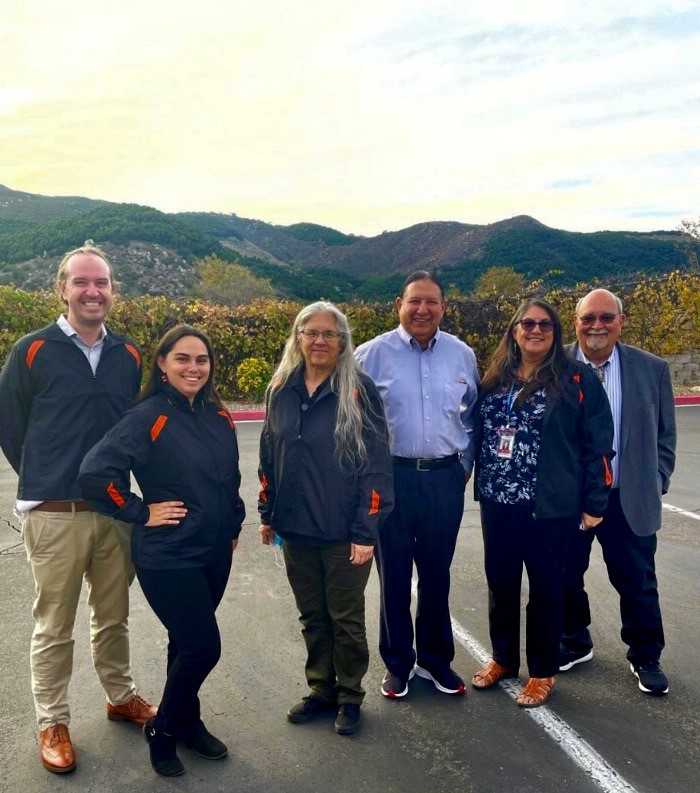
My Two Aunties partners with nine local tribes, the local Indian Health Council and San Diego County, and is funded by California’s Office of Child Abuse Prevention and the Department of Social Services.
The key component is the “aunties,” whose role “builds upon the strengths of family legacies, patterns, and kinship traditions that have endured since time immemorial,” the My Two Aunties’ program guide states. In contrast to the fear instilled by county social workers going into the homes of parents under threat of child removal, Lycett describes her work as an abundance of acceptance and understanding. Some home visits require just one auntie; others, two.
“When you have one auntie, everything is fine and dandy,” Lycett said with a grin. “But if two come into the door, you better duck for cover.”
Lycett, 28 and fellow auntie Cori Biggs, 63, are descended from the San Pasqual Band of Mission Indians. Lycett has an associate degree in sociology and is studying for a bachelor’s degree in the sociology field. She has been trained in the well-regarded Family Spirit program since 2019. Biggs has a master’s degree in social work.
They aim to build relationships between children, parents and their tribes to combat the cultural erasure that happens when a child is taken from their tribal home. So in addition to training in case management, mandated reporting protocols and developing safety plans, they’re also versed in local languages, legends and Native history, including the impacts of colonization.
Aunties’ responsibilities include supporting parents at risk for abusing substances, working with pregnant moms and guiding families for one year after a child’s birth.
“WHENEVER WE’RE WORKING WITH THESE FAMILIES, THEY HAVE TO BE THE LEADER.”
— LIZZIE LYCETT, MY TWO AUNTIES
Lycett said “our first and foremost priority is the safety of our families,” and she and Biggs are mandated reporters of child abuse and neglect. If concerning issues arise that require a call to the child protection hotline, program staff may contact CPS, or encourage direct witnesses to do so. Aunties do not make foster care recommendations, however — that determination is made following an investigation by a tribal or county social worker.
Clients were not interviewed for this article to maintain their privacy, but feedback the program has received shows family members’ appreciation for the guidance and support. “Raising a Native baby to be proud of being Native is a huge thing,” one parent said in a survey response. “That’s something that I really wanted and the main reason I wanted to be in this program.”
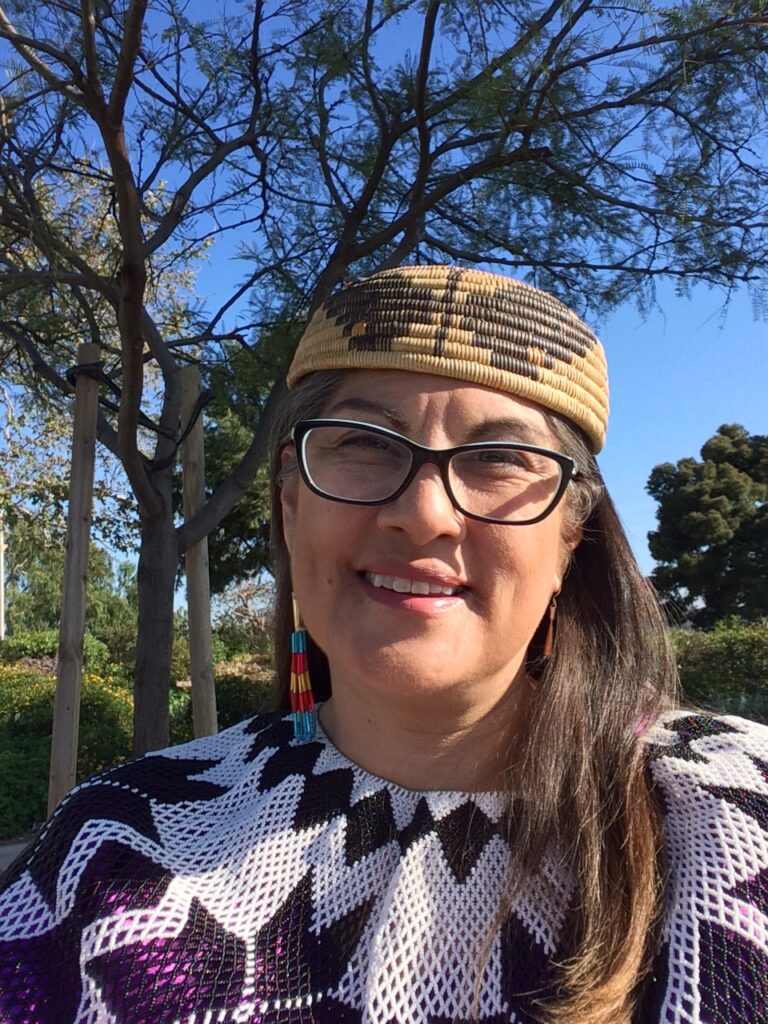
Former director Karan Thorne — a member of the Rincon Band of Luiseño Indians — retired last year after a three-decade journey to develop My Two Aunties. Thorne said that unlike the typical approach of social workers, the aunties focus on strengths within the household: “Instead of ‘What’s wrong with you?’ they ask: ‘What’s strong with you?’”
She said generations to come are being positively impacted.
“I’m seeing such great change with these pregnant women, and a lot of the babies have tribal names now,” Thorne said. “To me, that says they’re proud of their culture and where their kids are coming from.”
At a recent National Indian Child Welfare Association conference highlighting noteworthy practices across the country, the nonprofit Indian Health Council described the program as “well received” among the members it serves as a tribal health organization. “In our community it takes trust to build a relationship,” a representative said. “It appears our Aunties are able to make that connection.”
Art Martinez of the Chumash tribe is a consulting psychologist who has worked on its curriculum and evaluations. He said the strength of My Two Aunties lies in the people it serves.
“In our ways, we never had child removal,” Martinez said. “We never had prisons, we never had jails. Why? Because we worked off a very basic understanding of living an honorable life in the way we were meant to be and the way we were meant to represent our own families.”
Martinez said he sees the program’s current caseload growing and shifting — from parents who are required by the court to participate, to parents who want to participate to reconnect with their cultural and spiritual pasts.
“IF BOTH OF THE AUNTIES COME IN, IT’S NOT NECESSARILY A REPRIMAND. IT’S, ‘LET ME TAKE CARE OF THE CHILD OVER HERE, SO YOU CAN HAVE YOUR CLASS.’”
— LIZZIE LYCETT, MY TWO AUNTIES
The My Two Aunties curriculum begins with lessons structured around the growth of an acorn into an oak tree.
Lessons in the roots that strengthen families and communities involve practicing patience and staying grounded in tradition. The course evolves through teachings about a balanced diet and healthy relationships, and ends in a final class symbolized by a drawing of a towering oak. The tree is surrounded by a forest fed by the knowledge of elders, ancestral medicine and spiritual practice.
The aunties’ caseloads have grown steadily over the past four years, including parents who voluntarily seek their support and services, and those referred by physicians. Clients of the child welfare system arrive at different stages — some parents are under investigation for child maltreatment, some have children placed in foster homes, and others are in the final stages of reunification. Each family receives between one and 12 visits, depending on the level of need.
In 2022, the program served 97 families and held 411 parenting classes. Those numbers have grown from 2021, when the program assisted 73 families and provided 133 parenting classes.
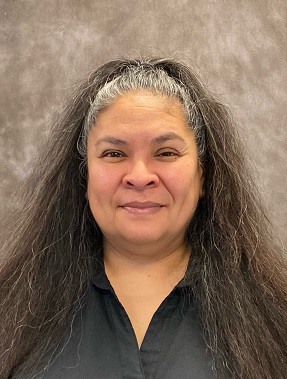
During the height of the COVID-19 pandemic, families picked up workbooks and other material at outdoor drive-through sites, and dozens of mothers received pre- and post-natal check-ins through video conferencing. But new opportunities were created as well, and the program continues to connect with families through virtual visits.
“It’s an option that has proven to be very convenient for our families and sometimes increases the chances that they will participate in the program,” current director Nancy Spence said.
The work of relying on traditional teachings to reduce the number of tribal families separated by foster care began over 20 years ago in this community. At the time, the consortium of tribes served by the Indian Health Council’s Tribal Family Services had nearly 500 children in local child welfare systems.
Indian Health Council data show there are currently 30 children in out-of-home care among the populations served by the agency serves, who include members of nine federally recognized tribes in San Diego, Imperial and Riverside counties.
My Two Aunties is a key contributor to the low numbers in recent years, according to the organization.
After publishing its 2022 evaluation report, the program is now working on its next robust set of findings. The measures that are being examined by Martinez and Jeremy Braithwaite of the Tribal Law and Policy Institute focus on the program’s ability to strengthen families: “How did families’ participation in various aspects of the program build/enhance/restore cultural resilience and how did they see this contributing to stronger, healthier families?” Braithwaite noted in an email. The evaluation centers on Indigenous Ways of Knowing methods, which the researcher described as “both culturally and scientifically rigorous.”
A final report on outcomes-to-date is forthcoming. But state data already show why the program is urgently needed in these southern California counties.
Native children make up roughly 600 of the more than 52,000 children in foster care in the state, or just 1.3%. But like Black children, they are, relative to their population size, the most likely to be reported as subjects of maltreatment and to enter foster care, according to state data.
“WHEN MY CLIENTS DON’T REUNIFY, I TELL THEM TO GET THAT ROOM READY ANYWAY. BECAUSE EVEN THOUGH HE’S IN FOSTER CARE, HE’S GOING TO AGE OUT AND COME HOME, SO YOU HAVE TO BE READY.”
— KARAN THORNE, FORMER DIRECTOR, MY TWO AUNTIES
The aunties’ care of these children’s families stands in stark contrast with the approach of county child welfare agencies — and it is more broadly defined. Some work is preventive — such as parents who have a family member with substance use disorder and need support “to ensure both the resiliency of the family and the family’s place in a Native community of wellness,” the program’s description states.
Others, even after losing their custody rights to their children, remain in the program — parents who’ve had their rights terminated are still treated as care-worthy.
“When my clients don’t reunify, I tell them to get that room ready anyway,” said former director Thorne. “Because even though he’s in foster care, he’s going to age out and come home so you have to be ready.”
The care is distinct in other ways as well. The aunties address and acknowledge the struggles Indigenous parents face that is a result of colonization, misrepresentation and social worker bias. Thorne said skepticism about Indigenous peoples’ ability to care for themselves and their families leads to the disproportionate numbers of child removals in Native communities. That includes conflating child neglect with poverty, in tribal communities, where as many as one-third live below the federal income level.
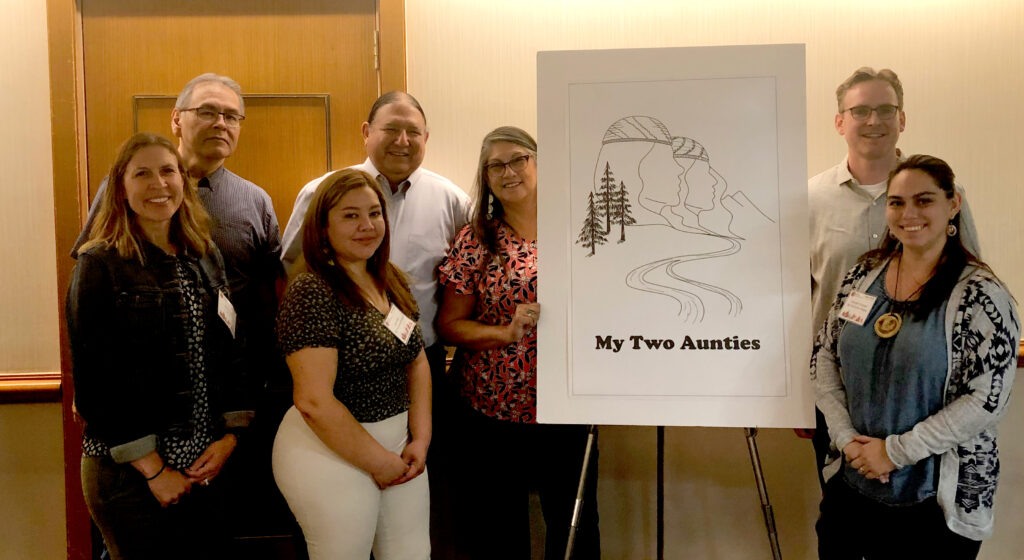
“You have to get to that root cause of what’s really happening with these families,” Thorne said, noting that too often, children are removed because of “conditions that non-Native social workers didn’t feel were right.”
Under the 1978 Indian Child Welfare Act (ICWA) and state law in California, child welfare agencies must make extra efforts to avoid the separation of Native families. To address historic injustice, that means making “active” — not simply “reasonable” — efforts to provide services to parents and to avoid placing children away from kin. That work is another central goal of My Two Aunties.
“ICWA says social workers have to use active efforts to help reunify families,” Thorne said. “We’re doing the active efforts to prevent those removals.”
The distrust parents have toward child welfare agencies in low-income and communities of color is not an exceptional experience in California or among tribal members. Lycett has seen it first-hand. In her initial home visits, she routinely encounters tension that must be overcome before she can earn a family’s trust. Some of her clients have a deep-seated fear of social workers taking away their children, and they’ve been left to feel powerless.
“With historical trauma and generational trauma, these families view social services as the Big Bad Wolf,” Lycett said. “Whenever we’re working with these families, they have to be the leader.”
To counter the mistrust, the My Two Aunties model is anchored in storytelling: “native cosmologies or ways of knowing related to the seasons, nature, familial kinship relations, spirits or trickster figures.” These oral traditions “carry the weight of wisdom passed on through countless generations,” the program description states, imparting “important lessons about how one should act in the world.”
“RAISING A NATIVE BABY TO BE PROUD OF BEING NATIVE IS A HUGE THING. THAT’S SOMETHING THAT I REALLY WANTED AND THE MAIN REASON I WANTED TO BE IN THIS PROGRAM.”
— PARENT SURVEY RESPONSE
To that end, the program’s Cultural Family Life Skills Discussion Guide curriculum draws on the storytelling traditions of southern California tribes. Life lessons are taught through an array of human and animal characters. A lesson in humility, for example, involves Turkey Vulture — whose now-bald head was scorched after Coyote tricked it into putting its head in a fire pit.
A version of the widely told Legend of the Three Sisters is another theme. In it, three sisters are going through the forest when they pass a river, and hear infant cries. As they get closer to the river, they see babies in the water.
The first sister jumps in immediately to save them. Thorne said this represents the Indian Health Council’s work with families navigating dependency courts. The second sister jumps in next, helping kids swim ashore. This sister represents foster care prevention skills — the work coaching families to heath and wellness through culturally-relevant lessons and values. The third sister goes upstream to keep any future children from falling into the river, which represents their prevention services.
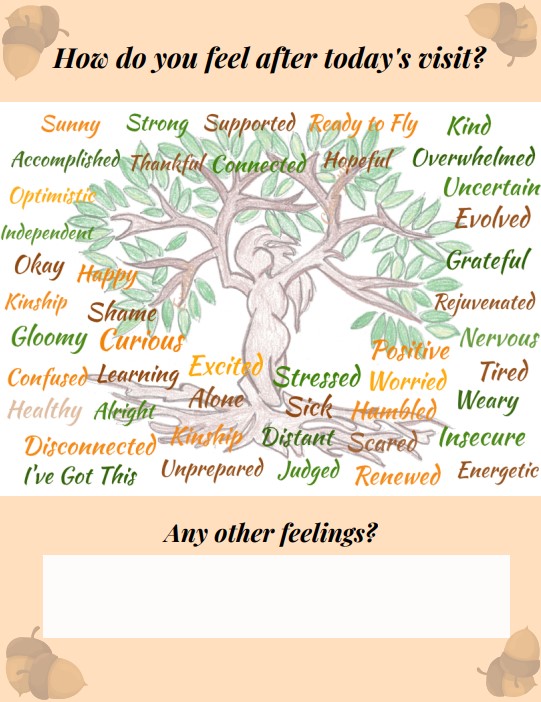
When parents are finishing their My Two Aunties visits, they fill out a Personal Reflection Tool worksheet.
The document features a giant tree in the shape of a woman’s form, with deep roots beneath her feet and powerful branches for limbs. Around the tree are words for parents to pick from that span the emotional spectrum: Alone. Shame. Uncertain. Supported. Grateful. Rejuvenated. Positive. Stressed. Parents circle four or five primary emotions they are experiencing.
Filling out this worksheet began as a tool for evaluators to gather insights on the program’s impact, tracking any changes over time. But it has since become a routine part of aunties’ visits. Of the dozen parents who participated in the latest evaluation, eight consented to their worksheet responses being used. None circled the words “alone,” “shame,” or “scared.”
One mother described moving from initial feelings of insecurity to empowerment. She reported feeling more motivated and happier as visits progressed. And she was learning to look toward the future with optimism.
Reflecting on the Mighty Oak lesson of the day, she acknowledged ongoing struggles, circling: “tired” and “stressed.” But she circled three hopeful words and phrases as well: “okay,” “I got this” and “positive.”
One of the auntie’s responses is noted in the evaluation.
“I was happy there were more positives than negatives,” she stated, “which shows the client is learning how to find hope and look forward to a better future for her and her family.”
This story is the first in an ongoing series by The Imprint examining tribal child welfare best practices and the steps Indigenous communities are taking to heal from and limit the use of foster care.
